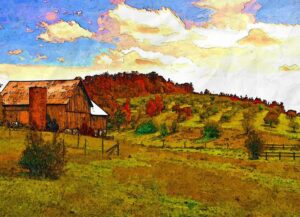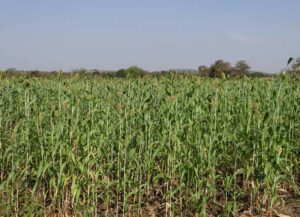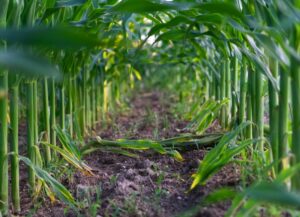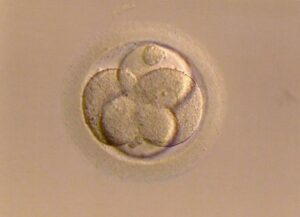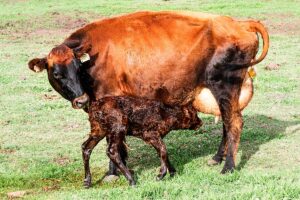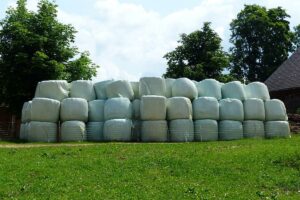Francisco E. Contreras Govea
Typical recommendations for harvesting cereal small grains for silage have been an issue for many years. If the main goal is to maximize silage nutritive value, without considering DM yield then, the recommendation has been to harvest at boot stage. On the other hand, if the main goal is to maximize yield without sacrificing nutritive value, then the recommendations is to harvest at soft-dough stage. Harvesting at boot stage DM yield is lower by 31% (7.4 Ton/ha) relative to soft-dough stage. These recommendations have been developed from the agronomic standpoint and laboratory analysis, without feeding to dairy cows (Contreras- Govea et al., 2006; Coblentz et al., 2018).
In a recent study conducted by Randby et al. (2019), whole wheat was harvested at two maturity stages, early dough and soft to hard dough, and then baled and wrapped in plastic without additives for a minimum of 90 days. After a period of fermentation, bales were frozen and kept in the freezer until the feeding trial started. Before starting of the trial, half of the bales from each maturity stage were processed to reduce the particle size of the kernels. Then from each part of the wheat silage at each maturity stage, processed and no-processed, 4 treatments total, were formulated the four diets.
Whole wheat silage was offered ad libitum as the only forage, plus 7.5 kg/d of supplemental concentrate to midlactation dairy cows (average of 155 DIM and 22.1 milk kg/d). Many data for different parameters were collected from this study, but the main purpose of this interpretation is to highlight differences between the whole wheat maturity stages and the effect on cow’s performance.
Table 1. Nutritive value (% of DM) of whole wheat silage harvested at two maturity stages and milk performance of mid-lactating dairy cows
| Parameter | Wheat Early Dough | Wheat Soft Dough |
| Dry Matter | 33.3 | 42.3 |
| pH | 4.35 | 4.71 |
| Protein | 10.3 | 10.3 |
| Starch | 11.0 | 25.4 |
| Neutral Detergent Fiber | 48.2 | 45.6 |
| Acid Detergent Fiber | 29.8 | 27.2 |
| INDF | 18.2 | 19.7 |
| Lactic acid | 5.1 | 2.9 |
| Acetic acid | 1.5 | 0.7 |
| Propionic acid | 0.9 | 0.9 |
| Ammonia-N | 0.3 | 0.2 |
| IVOMD | 67.4 | 65.8 |
| DM intake and production data | ||
| DM intake, kg/d | 13.8 | 14.4 |
| TTAD | 61.3 | 59.8 |
| Milk yield, kg | 20.5 | 20.6 |
| ECM, kg | 23.2 | 23.8 |
INDF=indigestible NDF; IVOMD=in vitro organic matter digestibility; TTAD= total tract apparent digestibility; ECM= energy corrected milk
The results indicated that there were not effects of wheat processing on any of the nutritive value parameters. Therefore, unprocessed and processed values were averaged (Table 1). Whole wheat nutritive value, protein, NDF, ADF, and in vitro digestibility were similar between the two maturity stages, which differs from previous studies, where typically NDF and ADF increase and digestibility decrease as maturity progress. On the hand, starch content was greater on the soft dough stage than on early dough. Such small difference between the nutritive value of the two wheat silages could explain the similar cow’s performance, even the greater DM intake and milk yield of cows fed soft dough wheat, which had greater starch content.
In summary, whole wheat silage harvested in either early dough or soft dough stage can be fed to midlactation dairy cows without precluding cow’s performance. However, a different cow’s performance could be expected from early lactating cows.
References
- Contreras-Govea, F.E., Albrecht, K.A., Muck, R.E. 2006. Spring yield and silage characteristics of kura clover, winter wheat, and in mixtures. Agron. J. 98:781-787.
- Coblentz, W.K., Akins, M.S., Kalscheur, K.F., Brink, G.E., Cavadini, J.S. 2018. Effects of growth stage and growing degree day accumulations on triticale forages: 2. In vitro disappearance of neutral detergent fiber. J. of Dairy Sci. 101:8986-9003.
- Randby, A.T., Nadeau, E., Karlsson, L., Johansen, A. 2019. Effect of maturity stage at harvest and kernel processing of whole crop wheat silage on digestibility of dairy cows. Anim. Feed Sci. Technol. 253:141-152.
© 2019 Dairy Knowledge Center, LLC. All Rights Reserved.



